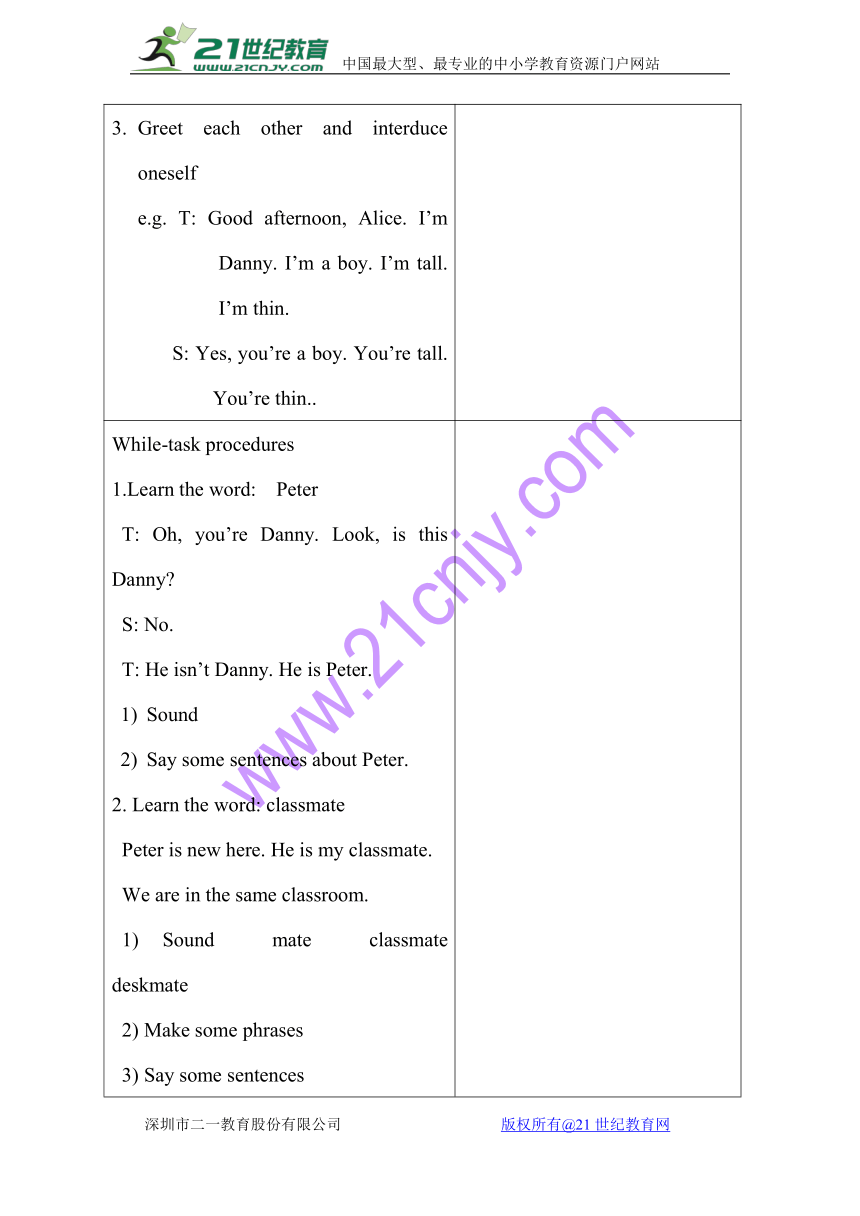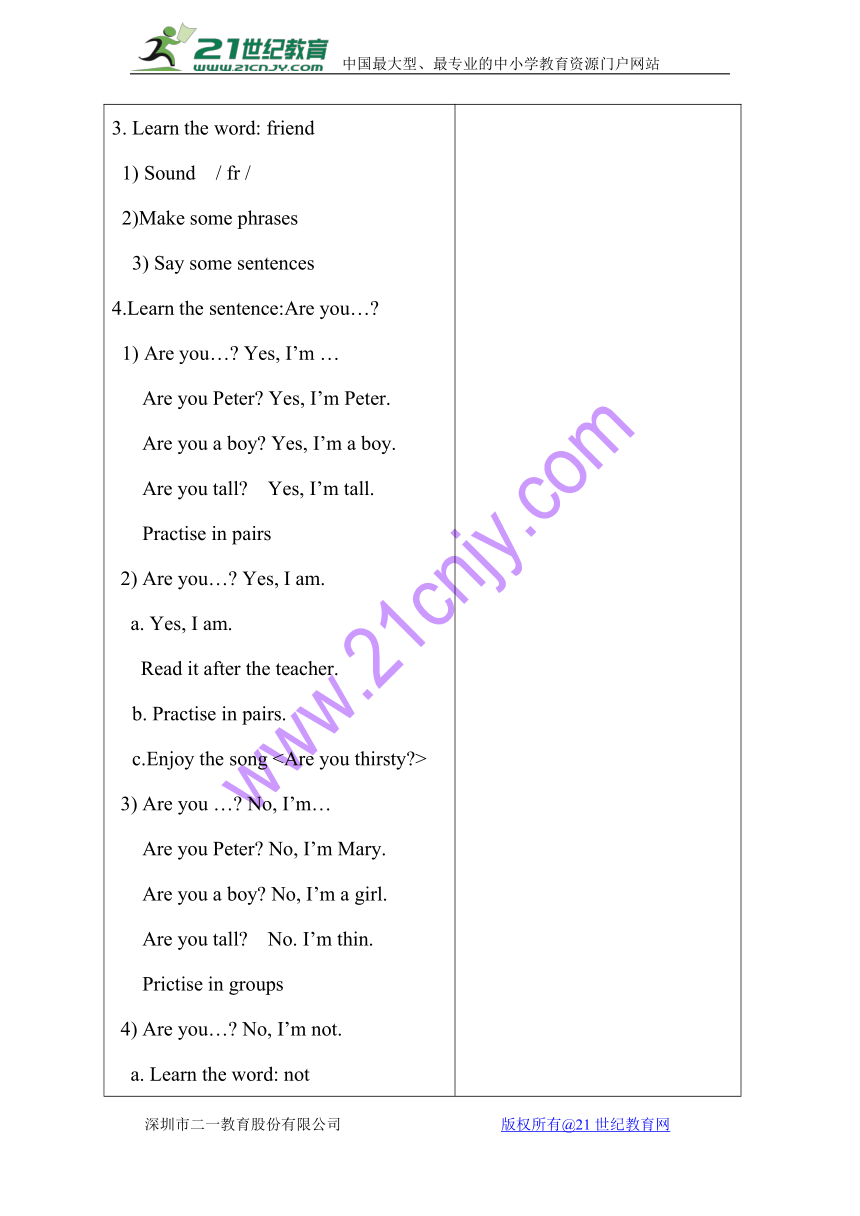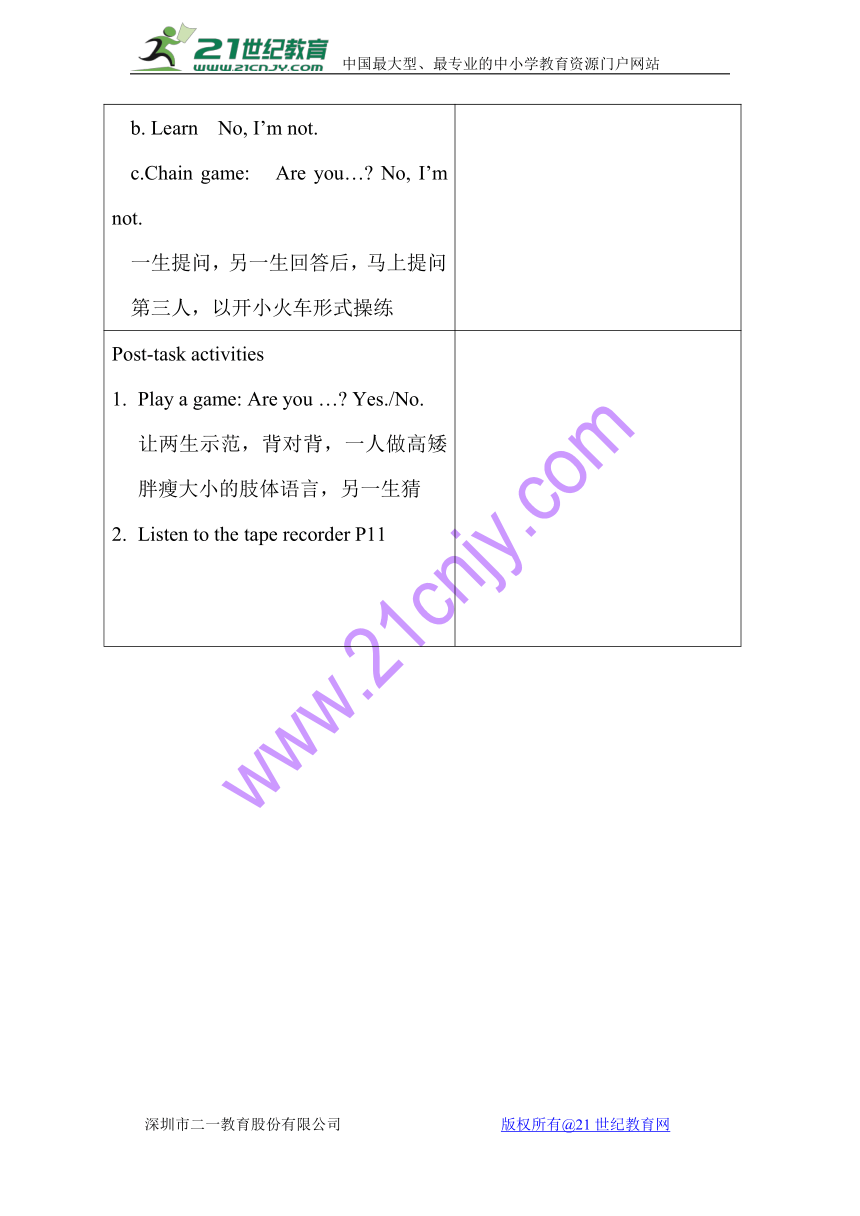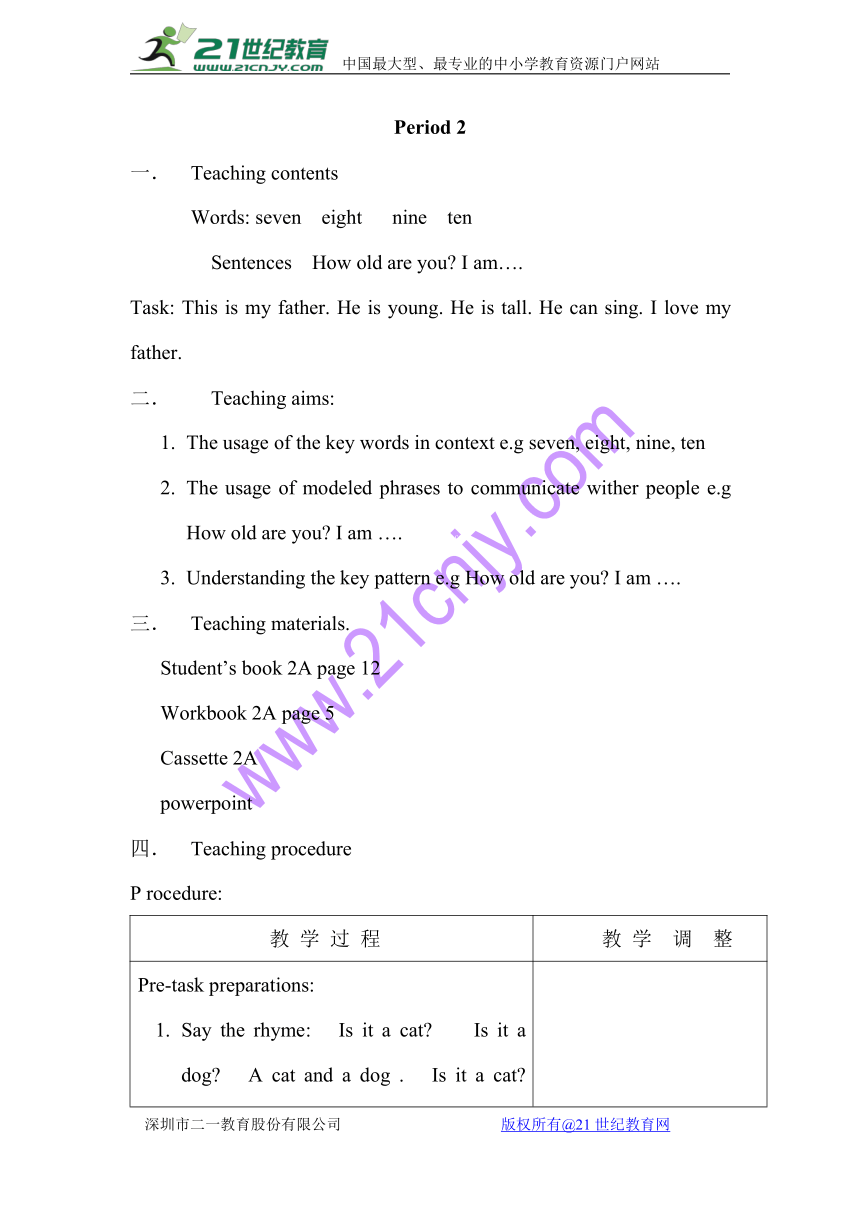Unit 3 Are you Alice? 教案
文档属性
| 名称 | Unit 3 Are you Alice? 教案 |  | |
| 格式 | zip | ||
| 文件大小 | 124.3KB | ||
| 资源类型 | 教案 | ||
| 版本资源 | 牛津深圳版 | ||
| 科目 | 英语 | ||
| 更新时间 | 2017-12-09 18:18:55 | ||
图片预览





文档简介
M1 Unit3 Period 1
Teaching contents
The usage of the key words in context
e.g. Peter classmate friend not
The usage of key patterns to respond appropriately21·cn·jy·com
e.g.Are you …? Yes, I am. / No, I’m not.
Yes, I’m…/ No, I,m not…
Teaching aims
Identifying the key words by listening to the pronunciation
e.g. Peter classmate friend not
Understanding key patterns and responding appropriately
e.g.Are you…? Yes, I am. / No, I’m not.
Yes, I’m…/ No, I,m not…
Teaching materials
Student’s Book 2A, pp11.
Cassette 2A
Flashcards 2A
Teaching procedures
导学过程
教学调整
Pre-task preparations
Enjoy the rhyme “ I’m … You ’re…”
Play a guessing game “ Who am I?”
Greet each other and interduce oneself
e.g. T: Good afternoon, Alice. I’m Danny. I’m a boy. I’m tall. I’m thin.
S: Yes, you’re a boy. You’re tall. You’re thin..
While-task procedures
1.Learn the word: Peter
T: Oh, you’re Danny. Look, is this Danny?
S: No.
T: He isn’t Danny. He is Peter.
Sound
Say some sentences about Peter.
2. Learn the word: classmate
Peter is new here. He is my classmate.
We are in the same classroom.
1) Sound mate classmate deskmate
2) Make some phrases
3) Say some sentences
3. Learn the word: friend
1) Sound / fr /
2)Make some phrases
3) Say some sentences
4.Learn the sentence:Are you…?
1) Are you…? Yes, I’m …
Are you Peter? Yes, I’m Peter.
Are you a boy? Yes, I’m a boy.
Are you tall? Yes, I’m tall.
Practise in pairs
2) Are you…? Yes, I am.
a. Yes, I am.
Read it after the teacher.
b. Practise in pairs.
c.Enjoy the song
3) Are you …? No, I’m…
Are you Peter? No, I’m Mary.
Are you a boy? No, I’m a girl.
Are you tall? No. I’m thin.
Prictise in groups
4) Are you…? No, I’m not.
a. Learn the word: not
b. Learn No, I’m not.
c.Chain game: Are you…? No, I’m not.
一生提问,另一生回答后,马上提问第三人,以开小火车形式操练
Post-task activities
Play a game: Are you …? Yes./No.
让两生示范,背对背,一人做高矮胖瘦大小的肢体语言,另一生猜
Listen to the tape recorder P11
Period 2
Teaching contents
Words: seven eight nine ten
Sentences How old are you? I am….
Task: This is my father. He is young. He is tall. He can sing. I love my father.21世纪教育网版权所有
Teaching aims:
The usage of the key words in context e.g seven, eight, nine, ten
The usage of modeled phrases to communicate wither people e.g How old are you? I am ….www.21-cn-jy.com
Understanding the key pattern e.g How old are you? I am ….
Teaching materials.
Student’s book 2A page 12
Workbook 2A page 5
Cassette 2A
powerpoint
Teaching procedure
P rocedure:
教 学 过 程
教 学 调 整
Pre-task preparations:
Say the rhyme: Is it a cat? Is it a dog? A cat and a dog . Is it a cat? Yes, it’s a cat. Is it a dog? Yes, It’s a dog.
sing a song : ten little paper rabbits
3.. Greetings.
4.Revision
a: Look at the pictures and answer the question
How many ….?
b: Count the numbers from 1---6.
While-task procedures:
1. word : seven
A : Look at the picture. What can you see?
I see …. How many …..can you see?
B :Elicit the new words by the dialogue.
C: Sound and the spelling.
D: Make phrases by the word seven.
2. eight
A:. Are you seven?
No, I am eight.
B: Elicit the word eight.
C: Pronunciation and the spelling
D: Make sentences by eight
e.g I am eight years old.
I see eight birds.
nine
A: Elicit the word by the dialogue:
Are you seven? No.
Are you eight? No.
How old are you?
I am nine years old.
B: The pronunciation and the spelling
C: read the phrases 789 879 978 987
D: Say the rhyme one two three I am a bee.
the sentence: How old are you?
a: How are you?-----How old are you?
b: Compare the two sentences.
c. Compare the two answers
d: Ask and answer
How old are you?
I am …..
The word: ten
A: Choose one student who is ten years old and ask him : How old are you?
B: reading and spelling
C. make phrases by the words
D: sing the song ten little paper rabbits
Post-task activities:
Have the students play a game in pairs. First, ask them to write down a student’s name and age on a piece of paper. Then hide it and ask the partner to guess. E.g S1:write Judy 7 S2: Are you seven? S1/;No, I am a girl. S2: Are you seven? S1: Yes, I am . S2: Are you Judy? S1: Yes, I am Judy.
Homework:
a: Listen and read the words and sentences we have learned in this class.
b:Do the exercise of workbook.
Period 3
Teaching contents
Letters: Ee and Ff
Listen and enjoy
Teaching aims:
Be able to pronounce the letters Ee and Ff correctly and identify them by listening the pronunciation21教育网
Be able to understand the chant and say it correctly with rhythm.
Teaching materials:
Student’s Book 2A, pp. 10 and 13
Workbook 2A, pp. 11 and 12
Cassette 2A
A powerpoint
Teaching procedures:
导学方法
设计说明
Pre-task preparation
Enjoy a song “Rain, rain, go away” and “My face”
Quick response.
Touch your …
While-task procedures
knees
Elicit by quick response
Sound.
Act and say: Touch your knees.
Say the chant: One, two, three,
Touch your knees.
Pick up …
Elicit by a question: What do you see on the floor?
Sound: chick, tick, pick
Look and say: Pick up …(pencil, book, rubber, etc.)
sticks
Elicit by a picture of a tree
Sound: stand, chicks, sticks
Say the sentences: I see sticks. Pick up sticks.
Say the chant:
One, two, three,
Touch your knees
Four, five, six,
Pick up sticks.
4. snake
A. Elicit by listening to the chant:
Seven and eight, draw a snake.
B. Sound: cake, snake
C. Do you like the snake?
D. Read the chant.
do it again
A. Elicit by drawing the snake
B. Read the phrases: come again, do it again
C. Read the chant: Nine and ten, do it again.
Listen, read and act the chant on pp. 10
6. elephant
A. Read a riddle to elicit “elephant”.
B. Sound: egg, elephant
C. Talk about the elephant.
D. Count the elephants.( The rhyme on pp.13)
Letters Ee and Ff
A. Read the initial letters in “elephant” and “five”
B. Find the sounds: /e/, /f/
C. List some words that contain the sounds.
Post-task activities
Workbook, pp.11: C. Listen and circle
Workbook, pp.12: E. Read and write.
Before students do the exercise, teach them how to write the letters Ee and Ff.
Homework
Listen and practise pp. 10 and 13.
Write the letters and the words.
教学反思:The usage of the key words in context
e.g. Peter classmate friend not
The usage of key patterns to respond appropriately21cnjy.com
e.g.Are you …? Yes, I am. / No, I’m not.
Yes, I’m…/ No, I,m not…
Teaching contents
The usage of the key words in context
e.g. Peter classmate friend not
The usage of key patterns to respond appropriately21·cn·jy·com
e.g.Are you …? Yes, I am. / No, I’m not.
Yes, I’m…/ No, I,m not…
Teaching aims
Identifying the key words by listening to the pronunciation
e.g. Peter classmate friend not
Understanding key patterns and responding appropriately
e.g.Are you…? Yes, I am. / No, I’m not.
Yes, I’m…/ No, I,m not…
Teaching materials
Student’s Book 2A, pp11.
Cassette 2A
Flashcards 2A
Teaching procedures
导学过程
教学调整
Pre-task preparations
Enjoy the rhyme “ I’m … You ’re…”
Play a guessing game “ Who am I?”
Greet each other and interduce oneself
e.g. T: Good afternoon, Alice. I’m Danny. I’m a boy. I’m tall. I’m thin.
S: Yes, you’re a boy. You’re tall. You’re thin..
While-task procedures
1.Learn the word: Peter
T: Oh, you’re Danny. Look, is this Danny?
S: No.
T: He isn’t Danny. He is Peter.
Sound
Say some sentences about Peter.
2. Learn the word: classmate
Peter is new here. He is my classmate.
We are in the same classroom.
1) Sound mate classmate deskmate
2) Make some phrases
3) Say some sentences
3. Learn the word: friend
1) Sound / fr /
2)Make some phrases
3) Say some sentences
4.Learn the sentence:Are you…?
1) Are you…? Yes, I’m …
Are you Peter? Yes, I’m Peter.
Are you a boy? Yes, I’m a boy.
Are you tall? Yes, I’m tall.
Practise in pairs
2) Are you…? Yes, I am.
a. Yes, I am.
Read it after the teacher.
b. Practise in pairs.
c.Enjoy the song
3) Are you …? No, I’m…
Are you Peter? No, I’m Mary.
Are you a boy? No, I’m a girl.
Are you tall? No. I’m thin.
Prictise in groups
4) Are you…? No, I’m not.
a. Learn the word: not
b. Learn No, I’m not.
c.Chain game: Are you…? No, I’m not.
一生提问,另一生回答后,马上提问第三人,以开小火车形式操练
Post-task activities
Play a game: Are you …? Yes./No.
让两生示范,背对背,一人做高矮胖瘦大小的肢体语言,另一生猜
Listen to the tape recorder P11
Period 2
Teaching contents
Words: seven eight nine ten
Sentences How old are you? I am….
Task: This is my father. He is young. He is tall. He can sing. I love my father.21世纪教育网版权所有
Teaching aims:
The usage of the key words in context e.g seven, eight, nine, ten
The usage of modeled phrases to communicate wither people e.g How old are you? I am ….www.21-cn-jy.com
Understanding the key pattern e.g How old are you? I am ….
Teaching materials.
Student’s book 2A page 12
Workbook 2A page 5
Cassette 2A
powerpoint
Teaching procedure
P rocedure:
教 学 过 程
教 学 调 整
Pre-task preparations:
Say the rhyme: Is it a cat? Is it a dog? A cat and a dog . Is it a cat? Yes, it’s a cat. Is it a dog? Yes, It’s a dog.
sing a song : ten little paper rabbits
3.. Greetings.
4.Revision
a: Look at the pictures and answer the question
How many ….?
b: Count the numbers from 1---6.
While-task procedures:
1. word : seven
A : Look at the picture. What can you see?
I see …. How many …..can you see?
B :Elicit the new words by the dialogue.
C: Sound and the spelling.
D: Make phrases by the word seven.
2. eight
A:. Are you seven?
No, I am eight.
B: Elicit the word eight.
C: Pronunciation and the spelling
D: Make sentences by eight
e.g I am eight years old.
I see eight birds.
nine
A: Elicit the word by the dialogue:
Are you seven? No.
Are you eight? No.
How old are you?
I am nine years old.
B: The pronunciation and the spelling
C: read the phrases 789 879 978 987
D: Say the rhyme one two three I am a bee.
the sentence: How old are you?
a: How are you?-----How old are you?
b: Compare the two sentences.
c. Compare the two answers
d: Ask and answer
How old are you?
I am …..
The word: ten
A: Choose one student who is ten years old and ask him : How old are you?
B: reading and spelling
C. make phrases by the words
D: sing the song ten little paper rabbits
Post-task activities:
Have the students play a game in pairs. First, ask them to write down a student’s name and age on a piece of paper. Then hide it and ask the partner to guess. E.g S1:write Judy 7 S2: Are you seven? S1/;No, I am a girl. S2: Are you seven? S1: Yes, I am . S2: Are you Judy? S1: Yes, I am Judy.
Homework:
a: Listen and read the words and sentences we have learned in this class.
b:Do the exercise of workbook.
Period 3
Teaching contents
Letters: Ee and Ff
Listen and enjoy
Teaching aims:
Be able to pronounce the letters Ee and Ff correctly and identify them by listening the pronunciation21教育网
Be able to understand the chant and say it correctly with rhythm.
Teaching materials:
Student’s Book 2A, pp. 10 and 13
Workbook 2A, pp. 11 and 12
Cassette 2A
A powerpoint
Teaching procedures:
导学方法
设计说明
Pre-task preparation
Enjoy a song “Rain, rain, go away” and “My face”
Quick response.
Touch your …
While-task procedures
knees
Elicit by quick response
Sound.
Act and say: Touch your knees.
Say the chant: One, two, three,
Touch your knees.
Pick up …
Elicit by a question: What do you see on the floor?
Sound: chick, tick, pick
Look and say: Pick up …(pencil, book, rubber, etc.)
sticks
Elicit by a picture of a tree
Sound: stand, chicks, sticks
Say the sentences: I see sticks. Pick up sticks.
Say the chant:
One, two, three,
Touch your knees
Four, five, six,
Pick up sticks.
4. snake
A. Elicit by listening to the chant:
Seven and eight, draw a snake.
B. Sound: cake, snake
C. Do you like the snake?
D. Read the chant.
do it again
A. Elicit by drawing the snake
B. Read the phrases: come again, do it again
C. Read the chant: Nine and ten, do it again.
Listen, read and act the chant on pp. 10
6. elephant
A. Read a riddle to elicit “elephant”.
B. Sound: egg, elephant
C. Talk about the elephant.
D. Count the elephants.( The rhyme on pp.13)
Letters Ee and Ff
A. Read the initial letters in “elephant” and “five”
B. Find the sounds: /e/, /f/
C. List some words that contain the sounds.
Post-task activities
Workbook, pp.11: C. Listen and circle
Workbook, pp.12: E. Read and write.
Before students do the exercise, teach them how to write the letters Ee and Ff.
Homework
Listen and practise pp. 10 and 13.
Write the letters and the words.
教学反思:The usage of the key words in context
e.g. Peter classmate friend not
The usage of key patterns to respond appropriately21cnjy.com
e.g.Are you …? Yes, I am. / No, I’m not.
Yes, I’m…/ No, I,m not…
同课章节目录
- Module 1 Getting to know you
- Unit 1 Good morning
- Unit 2 I'm Danny
- Unit 3 Are you Alice?
- Revision 1
- Module 2 My family, my friends and me
- Unit 4 Can you swim?
- Unit 5 That's my family
- Unit 6 My hair is short
- Revision 2
- Module 3 Places and activities
- Unit 7 In the playground
- Unit 8 In my room
- Unit 9 Dinner is ready
- Revision 3
- Module 4 The world around us
- Unit 10 In the sky
- Unit 11 In the forest
- Unit 12 In the street
- Revision 4
